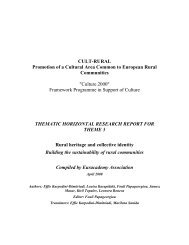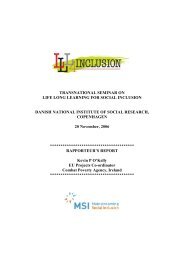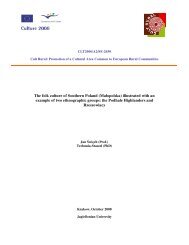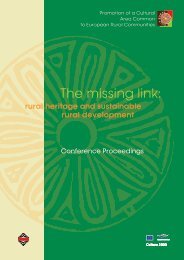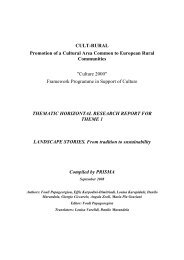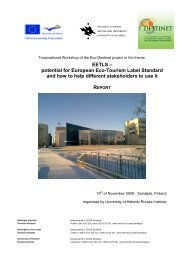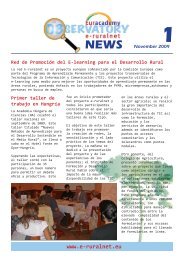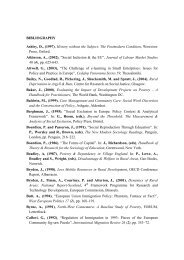ÐÐ¾Ð´Ð°Ñ Ð¿Ð¾ изложбаÑа - cult rural - Prisma
ÐÐ¾Ð´Ð°Ñ Ð¿Ð¾ изложбаÑа - cult rural - Prisma
ÐÐ¾Ð´Ð°Ñ Ð¿Ð¾ изложбаÑа - cult rural - Prisma
You also want an ePaper? Increase the reach of your titles
YUMPU automatically turns print PDFs into web optimized ePapers that Google loves.
SYMBOLISMS OF FERTILITY AND REBIRTH<br />
OF NATURE<br />
EASTER CELEBRATIONS<br />
Easter is the most signifi cant celebration for the Christian world. Closely<br />
associated with spring and the renaissance and rebirth of nature, it incorporates<br />
rituals and customs that can be traced back to past times and antiquity.<br />
In Greece, Easter – also known as Lambri or Anastasis (resurrection) –<br />
incorporates not only the religious element of Christ’s resurrection, but also is the<br />
most signifi cant spring celebration, symbolizing the joy of people for the revival of<br />
nature and the beginning of creativity.<br />
The highlight of Easter celebrations is the Holy Week, an extension and intense<br />
experience of Lent, full of symbolic actions contributing to the understanding<br />
of the Divine Drama. Although the ritual of the Orthodox Church is assumed by<br />
the priests (men), women are almost exclusively involved in the dressing of the<br />
Epitaph (Holy Sepulchre) and in the other preparations in the houses and in the<br />
Church. The almost exclusive participation of women in the practices celebrating<br />
Easter is explained by the fact that women are linked with fertility and growth,<br />
they give life and birth. Therefore all the customs and rites related with the<br />
death and resurrection of nature and humanity are dependant on the feminine<br />
knowledge and competence. Resurrection is preceded by Lazarus Saturday<br />
along with Palm Sunday, while the songs (agermoi) of Lazarus Saturday, bearing<br />
his name (Lazarus agermoi), are widely known and popular. Groups of boys and<br />
girls dramatically narrate the story of Lazarus and announce his resurrection<br />
while carrying baskets with freshly cut fl owers and collecting the eggs of Easter.<br />
In some cases only girls participate in the songs of Lazarus (named Lazarines)<br />
while married women are excluded. The reason for this is that Lazarus had only<br />
sisters. In Western Macedonia, Thessaly, Central Greece and the Peloponnese,<br />
the custom had an intense social character since it offered to girls the opportunity<br />
of coming into contact with the micro-community of their village, walk around<br />
the houses show off their skills and become known as potential brides. The<br />
Lazarines hold a basket decorated with flowers in which they place white<br />
eggs offered by the housewives. The baking of bread-made figures depicting<br />
Lazarus also carry a pre-resurrection symbolism (Aegean Islands), as well as<br />
the procession of effigies on flowery funeral beds of Lazarus (Epitaph) made out<br />
in rough shapes and colourfully decorated (Cyclades, Crete, Ionian, Epirus). In<br />
inland Greece, Lazarus breads are distributed for the dead man’s soul.<br />
Lazarus’ Saturday, before nightfall, is considered the most appropriate time<br />
to prepare the palm leaves that will decorate the churches the next day, Palm<br />
Sunday. The blessed palms along with the flowers will be distributed to the<br />
attendees of the service and be kept at their homes to drive away evil. In the<br />
<strong>rural</strong> areas they used to ritually strike the bundles in the fields, the trees and the<br />
vineyards.<br />
Holy Thursday and Holy Friday are associated with funerary customs. It is a<br />
common practice for women to visit the cemeteries and to decorate the graves<br />
with flowers. The most important event of Holy Friday is the evening procession<br />
of the Epitaph, led by the liturgical flags and the cross and in some places<br />
accompanied by local bands playing funeral marches. In most places a women<br />
39. Palm Sunday in Thessaloniki, Greece (phot.<br />
V.Voutsas)<br />
40. Easter eggs from Greece<br />
22<br />
41. Artwork "Egg", mixed technique by Constantina<br />
Katrakazou<br />
42. Hand woven palm leaves made by churchgoers in<br />
Greece, celebrating Palm Sunday<br />
39. 40




